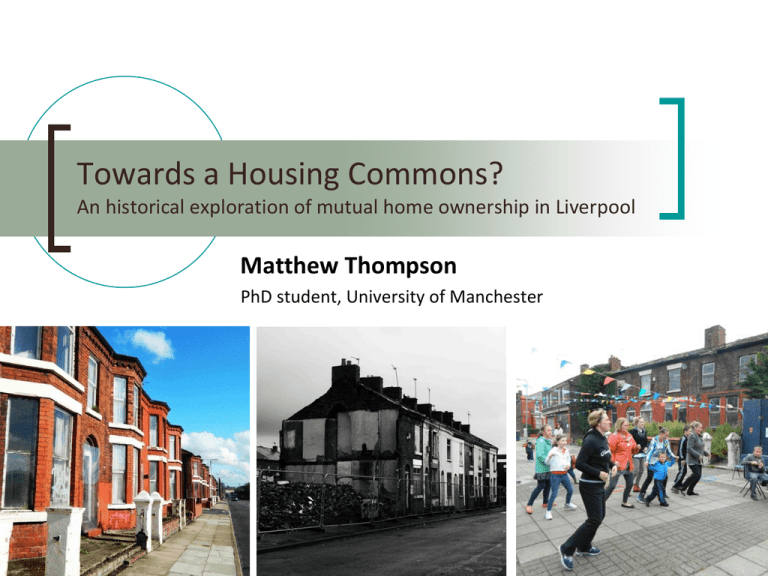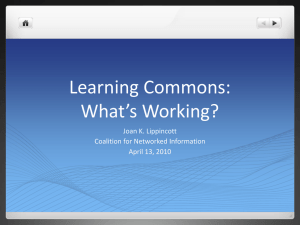`Pepper-potting` over the Class Divide
advertisement

Towards a Housing Commons? An historical exploration of mutual home ownership in Liverpool Matthew Thompson PhD student, University of Manchester PhD Research Historical study of different models and campaigns for mutual ownership of housing in Liverpool Understanding social, political and institutional conditions shaping the development of mutual housing initiatives Questioning what we mean by ‘successful development’ of such initiatives – what is mutual ownership of housing meant to achieve, and for who? Currently undertaking historical analysis and case study research – about to conduct 40 semi-structured interviews This paper theorises mutual ownership of housing as a housing ‘commons’ and presents initial research to unpack implications What does mutual ownership of housing have in common? Third way of ownership/provision: neither public nor private Voluntary membership of residents in housing association Capture of land value locally for member residents Recycle social surplus back into association to subsidise housing costs Perpetually affordable housing held in trust for future generations Collective, democratic decision-making: self-government Potentially radical alternative - but divergence in political radicalism across different models: Squatting, Cooperatives, Co-housing, Self-build, Tenant co-partnership, Community Gateway, Community Land Trusts, Development Trusts Why now? Contemporary Catalysts Housing Crisis and (un)affordability Privatisation of Public Housing average house price to earnings ratio doubling from just 2.7 to 1 a decade ago to 5.4 to 1 in 2005 (Wilcox, 2005). ‘Wobbly pillar’ of welfare state – third of all provision in 1970s, now only 18% Council housing ‘residualisation’ – Right to Buy and Stock transfer to RSLs Austerity Localism? Public sector cuts since 2008 financial crisis – offloading of services Withdrawal of state funding of large-scale regeneration (e.g. HMR) Localism and Big Society (Community Rights to Buy/Build/Bid) Cross-party political support and funding for asset transfer to communities (Quirk Review) Rationale for mutual alternatives 1) Exploitation 2) Alienation 3) Council housing residualisation, public/absentee landlordism Displacement Housing crisis, speculation, lack of access to affordable housing Gentrification, state-led regeneration demolition (e.g. HMR) Due to separation of producer and consumer of housing: “The capital-relation presupposes a complete separation between the workers and the ownership of the conditions for the realisation of their labour… So-called primitive accumulation, therefore, is nothing else than the historical process of divorcing the producer from the means of production” Marx (1990) Capital vol. I, p.874-5 Reclaiming a Housing Commons? Capitalism predicated on enclosure of commons Mutual housing as a form of commons Initial acts of enclosure – dispossession of commoners from land Ongoing enclosure – privatisation of public housing, commodification Affordable housing as shared resource held in trust for future users De-commodification – reconnecting producer and consumer of housing Collective, cooperative self-government – social practices of commoning ‘Common Right’ over a housing commons? Use value over exchange value CLT community rights to ‘unearned social increment’ supersedes individuals’ ‘right to speculate’ and on mutually produced value Contradictions [1] ‘Common Right’ vs… Based on specificity of community / collective Moral claim over commons derived from legitimate interest of mutual use, production, inhabitation, embeddedness and interaction in community Intrinsic legitimacy from negotiation among users – self-government Private Property Rights Based on universality of citizenship / individualistic Abstract legal entitlement to access property, resources Extrinsic legitimacy from appeal to higher authority (state) to adjudicate on and meet claims Contradictions [2] Inside vs. Outside Commons necessarily implies an ‘outside’ Inevitable exclusion of some potential users Territorial and membership boundaries Rules regulating access Inclusion vs. Exclusion Internally oppressive power relations Externally exclusive inward-looking groups that limit membership and refuse participation from most in need Competition between housing commons for scarce resources (land) Contradictions [3] Internal Autonomy vs. External Dependence Reliance on state support – legislation, funding, public land transfer Inserted into capitalist land markets – acquisition of land Horizontality vs. Verticality Needs intermediary organisations for skills, training, funding, knowledge sharing – e.g. National CLT Network, secondary coops Partnership working with professional organisation for expert advice Contradictions [4] Radical Alterity vs. Accommodation / Co-optation Source: (Hodkinson, 2012) Contradictions [5] Bottom-up campaign vs… Commons associated with radical grassroots activism Top-down policy solution State support of mutual ownership as alternative to public provision Plug gap left by retreating state – community self-help Community Rights to Buy/Build/Bid Empty Homes Fund and Self-build funding Contradictions [6] Prefigurative Politics vs…. Proactive practices towards more progressive social relations – utopian! Activist campaigns for ideological agendas (e.g. Green, Commons) Associated with middle class groups – elective belonging (Savage, 2010) Social Necessity Reactive to state or market failures in provision Community campaigns as responses to fulfil essential needs (housing) Bespoke solutions to particular problems (displacement, affordability) Associated with working class communities – elective fixity (Paton, 2012) Liverpool case studies Garden City movement 1910 Housing Cooperative movement 1977 1984 1987 Wavertree Garden Suburb Weller Streets Housing Coop – UK’s first resident-owned self-build coop Eldonian Housing Coop , UK’s largest community-owned housing trust today Langrove Community Housing Coop Contemporary CLT movement 2012 Homebaked – UK’s first urban CLT Granby Four Streets CLT campaign Little Klondyke CLT campaign Liverpool case studies: Reactive campaigns to state ‘ out of necessity’ 1970s coop campaigns – responses to demolition threat 1976 Liberal council tenement demolition programme – 57 ‘slum clearance areas’, included Weller Streets group and Eldonians’ Portland Gardens Coop 1983-87 Militant Council’s Urban Regeneration Strategy Municipalised 7 housing coops (including Eldonians’ Portland Gardens) Galvanised Eldonians into community activism – ‘Self-Regenerating Community’ bid for Tate & Lyle site eventually successful with funding Langrove Street Action Group formed in 1986 to oppose council’s plans to demolish houses for Everton Park development But hostile council refused planning permission – overturned in planning inquiry Occupation of houses led to successful establishment of housing coop 2003-11 Housing Market Renewal Pathfinder CLT campaigns to acquire empty homes under community ownership Realising a Housing Commons? Liverpool’s 1970s cooperative movement Successful partnerships and external support – Eldonians Merseyside Improved Housing (MIH) professional support – pro bono work, expert advice, leadership, initially proposed coop idea Thatcher government support – extension of Merseyside Dev. Corp. boundaries, funding for land acquisition set up by ‘Minister for Merseyside’ Support from English Estates (landowner) and Housing Corp. (funder) Engages with wider community, plans for expansion, knowledge sharing Internationally recognised – 2004 UN World Habitat Award Dangers of radical independence – Weller Streets Coop Gulf between ideologically radical leading members and other residents Only new-build to remain aggressively independent managing own services Rejection of CDS support as secondary coop; failure of own secondary coop Rejection of partnerships with other coops or Housing Corp – no funding Realising a Housing Commons? Liverpool’s contemporary CLT movement Homebaked CLT, Anfield Genesis as art project for Liverpool Biennial Success in social media and fundraising campaign Won 2012 CLT Network Award Designed by URBED who also did HMR masterplan Granby Four Streets, Toxteth Application to government’s Empty Homes Fund Working with city council, RSLs Plus Dane and Liverpool Mutual Homes, city police on steering group Little Klondyke CLT, Bootle Working with charity Maritime Community Development Agency Refusal of Sefton Council to approve otherwise successful application to DCLG for £5m funding Commons as interdependence Struggle for housing commons depends on external support Trade-off: political independence vs. successful institutionalisation Internal autonomy of commons dialectically related to external authority of state and market Reliant on state support – legislation, funding, public land transfer Local autonomy as mutual relationship with state – not freedom from state control Radical independence leads to marginalisation and co-optation Danger of New Enclosures and Militant Particularism Need Connections between housing commons for solidarity and support Challenge of creating successful, progressive, inclusive commons





